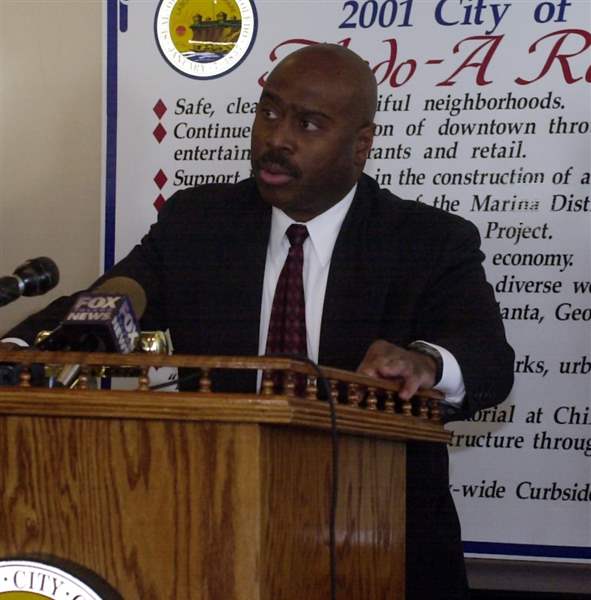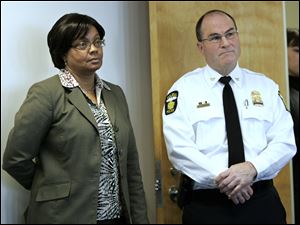
Chief seeks boost in police diversity
Toledo’s gains don’t satisfy everyone
5/1/2011
Deputy Police Chief Derrick Diggs says the root of the problem goes back decades and touches on the issue of how police treated minorities during the civil rights movement.
THE BLADE
Buy This Image

In 16 years on the Toledo police force, Michele Johnson witnessed gains in the number of women in the ranks and in leadership positions in the department.
In the nearly 16 years Michele Johnson was as a Toledo police officer, she watched the department change and diversify.
When she started in 1985, the department had very few women, and maybe two or three were in supervisory roles. By the time she retired in 2001, the number of women in leadership positions increased — women were sergeants, lieutenants, and the force had three or four women captains, said Ms. Johnson, chairman of the school of public safety and emergency preparedness at Owens Community College.
Although diversity in the Toledo Police Department has improved, Chief Mike Navarre said, “We have a lot of room for improvement.”
In August, 1972, a group of black and Hispanic plaintiffs brought two affirmative-action lawsuits against the city of Toledo, alleging that the police and fire departments’ employment policies violated their civil rights. The next year, a group of black and Hispanic police officers filed suit against the police department alleging discrimination in department promotions.
An agreement was reached in 1974 to change hiring practices, including a requirement that the departments’ employment figures must be a reflection of the community.
“The taxpayer looks at the city’s work force and they want to see the work force reflect them, and there’s nothing wrong with that,” said Shirley Green, deputy mayor for public safety and personnel. “If you have a diverse population that you police, it’s good to have a good, diverse police department. You bring in different types of experience that makes the department stronger.”
In the fall of 2010, the fire department’s consent decree was dismissed. The police department’s consent decree was dismissed in April, but the plaintiffs’ attorney filed a motion last week to reconsider the dismissal, said Ellen Grachek, a city attorney.
The police department now is representative of the city, Ms. Green said.
But Chief Navarre says the department is not diverse enough.

Deputy Police Chief Derrick Diggs says the root of the problem goes back decades and touches on the issue of how police treated minorities during the civil rights movement.
The police department, as of mid-April, was 76 percent white, 17 percent black, and 7 percent Hispanic. Women made up 19 percent of the department.
“[The Toledo Police Department] has come a long way, but it still has a way to go,” Ms. Johnson said.
New to the force
Chief Navarre led 30 bright-eyed police recruits through the officer’s oath on April 12, officially making the men and women police officers. Among the 28 men and 2 women receiving their badges that day was Lourdes Rocha, 33. She is the first Hispanic female to graduate from the Toledo Police Academy since at least 2001, according to department statistics.
The most recent class of 30 recruits — who entered the Toledo Police Academy in November and have been on the job for two weeks — is dominated by white males at about 80 percent of the class. Whites are nearly 87 percent of the total class.
The next-most-recent class to graduate from the Toledo Police Academy was hired in 2006. Of those 29 officers, more than 89 percent were white and only 20 percent were female, according to Toledo police.
Of the five classes to graduate in the past decade, 2002 represents the most racially diverse year with 53 percent white officers, 40 percent black officers, and nearly 7 percent Hispanic officers. But the class was 93 percent male.
A long-term issue
Recruiting minority officers is difficult and is an issue that departments across the country have to combat, Chief Navarre said.
Nationally, 83 percent of police officers are white and 14 percent are black; 13 percent are female, according to the U.S. Department of Labor’s Bureau of Labor Statistics.
“There are a lot of reasons,” the chief said. “One is a lack of interest in the job, and that is our challenge as a police department to generate that interest. We don’t seem to have that problem with nonminority candidates.”
It isn’t a new problem that police departments face. The root of the issue dates back decades, said Deputy Toledo police Chief Derrick Diggs.
“Minorities and police have had problems historically going all the way back to the riots in the … ‘60s and the civil rights movement, and how police mistreated minorities in the past,” Chief Diggs said.
Hired in 1977, Chief Diggs is the highest-ranking minority member of the Toledo Police Department. “Look at the commissions that were put together after the social upheavals in the mid-to-late ‘60s.
There’s one thing that’s glaringly clear: the fact that there’s a lack of minorities policing their communities, and [departments] need to be reflective of communities they serve.

Toledo Deputy Mayor for Public Safety and Personnel Shirley Green, with Chief Mike Navarre, says the police department is representative of the city’s population. But the chief says the department is not diverse enough.
“Very few parents ever told kids, ‘We want you to be a police officer.’ There are serious historical concerns that make law enforcement a profession that’s not pursued like some others.”
By comparison
Compared to other departments, Toledo fares pretty well in hiring minority officers.
In Dayton, less than 9 percent of the department is black, while blacks make up 42 percent of the city’s population. The Lexington, Ky., Police Department is 9 percent female; Akron’s department is 10 percent female.
Dayton, as part of a 2009 discrimination lawsuit settlement with the U.S. Department of Justice, had to develop a new selection process in hiring minority police and firefighters. The federal lawsuit accused the city of discriminating against blacks in hiring. The city plans to discard 748 test scores of people who passed the police exam and instead hire based on oral interviews.
Ms. Johnson has been approached by some of her women students who consider law enforcement careers but question themselves and the impact the career could have on their lives.
“I’ve sat down with a couple young ladies and the question is, ‘I’m a mother, I’m a parent, I don’t know how it’s going to affect my family life. … Will I still be seen as a woman opposed to just a policeman?’ Absolutely. It doesn’t take away from who you are or what you are.”
Reaching out
In the early 1980s, the department started a structured program geared toward recruiting minorities and women, Ms. Green said. Recruitment teams targeting women and minorities hosted meetings and put on “presentations to groups in African-American and Latino communities to generate interest in taking the police exam,” Ms. Green said.

In 2005, 2,384 people applied for the exam — applicants were 68 percent white, 20 percent black, and 7 percent Hispanic; 78 percent were male. When test day came, however, fewer than 60 percent of the applicants showed up. Whites dropped out of the pool at the highest rate — 61 percent — followed by Hispanics at 55 percent and blacks at 51 percent; 59 percent of the men and 56 percent of the women dropped out, statistics from the city show.
“It’s a pretty diverse group who will fill out interest cards to actually take the exam, or show interest in taking the exam,” Ms. Green said. “For minorities, the dropoff rate has been as high as 50 percent — and I don’t know if … there’s a lack of commitment and interest, or they just think about taking the test and drop out, or if it’s because there’s a time lag between when they apply and when the test is actually given.
“Those are some of the things we need to address and look at to try to keep interest among these candidates to becoming police officers.”
The class hired in April took the civil service exam six years ago.
“There are a lot of things that need to be done,” Chief Navarre said. “There are a lot of changes that need to be made because the current process inhibits minority hiring.”
‘Customer friendly’
A 2003 survey conducted by the Toledo Police Department highlights 42 departments and their hiring procedures. From the survey, Chief Navarre noted four changes the department could make to be more “customer friendly.” Included is changing the civil service exam from every two years to, ideally, every six months.
“We lose far too many quality minority candidates that have graduated from college with degrees in criminal justice and law enforcement because we don’t give the test frequently enough,” Chief Navarre said.
Based on the survey, the Aurora Police Department in Colorado falls in line with what Chief Navarre would like to see happen in Toledo. That department offers the civil service exam every six months and accepts applications online.
Lt. Vanessa Wilson, who works in Aurora’s recruiting section, said the department reaches out to minority communities nearby and across the country by traveling to national minority officer conferences.
“It’s definitely something all departments are struggling with,” Lieutenant Wilson said.
In November, a class of 50 recruits will start in the Toledo Police Academy. They will train for 24 weeks before becoming sworn officers and assigned to help protect the city.
“The comments I see in the community … they wonder, ‘Where are the black officers? Where are the minority officers? Where are the female officers?’ That’s what I hear,” Chief Diggs said. “I say to them, they’re out there. We’re always trying to improve what we do, and the officers are out there.”
Contact Taylor Dungjen at: tdungjen@theblade.com or 419-724-6054.